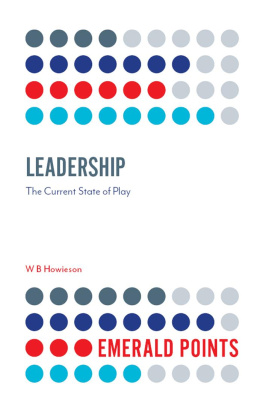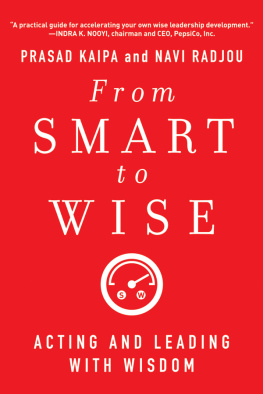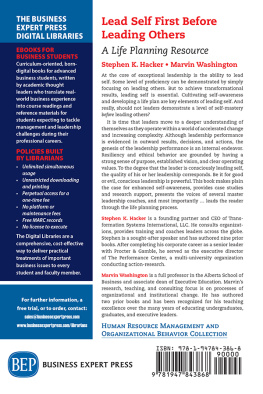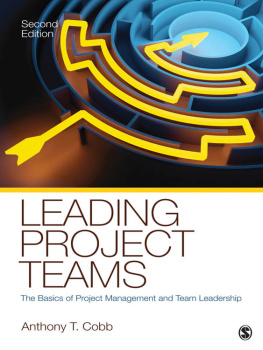Ronald R. Sims - Leadership, Leaders and Leading (Contemporary Human Resource Management Issues Challenges and Opportunities)
Here you can read online Ronald R. Sims - Leadership, Leaders and Leading (Contemporary Human Resource Management Issues Challenges and Opportunities) full text of the book (entire story) in english for free. Download pdf and epub, get meaning, cover and reviews about this ebook. genre: Business. Description of the work, (preface) as well as reviews are available. Best literature library LitArk.com created for fans of good reading and offers a wide selection of genres:
Romance novel
Science fiction
Adventure
Detective
Science
History
Home and family
Prose
Art
Politics
Computer
Non-fiction
Religion
Business
Children
Humor
Choose a favorite category and find really read worthwhile books. Enjoy immersion in the world of imagination, feel the emotions of the characters or learn something new for yourself, make an fascinating discovery.

- Book:Leadership, Leaders and Leading (Contemporary Human Resource Management Issues Challenges and Opportunities)
- Author:
- Genre:
- Rating:5 / 5
- Favourites:Add to favourites
- Your mark:
- 100
- 1
- 2
- 3
- 4
- 5
Leadership, Leaders and Leading (Contemporary Human Resource Management Issues Challenges and Opportunities): summary, description and annotation
We offer to read an annotation, description, summary or preface (depends on what the author of the book "Leadership, Leaders and Leading (Contemporary Human Resource Management Issues Challenges and Opportunities)" wrote himself). If you haven't found the necessary information about the book — write in the comments, we will try to find it.
Ronald R. Sims: author's other books
Who wrote Leadership, Leaders and Leading (Contemporary Human Resource Management Issues Challenges and Opportunities)? Find out the surname, the name of the author of the book and a list of all author's works by series.
Leadership, Leaders and Leading (Contemporary Human Resource Management Issues Challenges and Opportunities) — read online for free the complete book (whole text) full work
Below is the text of the book, divided by pages. System saving the place of the last page read, allows you to conveniently read the book "Leadership, Leaders and Leading (Contemporary Human Resource Management Issues Challenges and Opportunities)" online for free, without having to search again every time where you left off. Put a bookmark, and you can go to the page where you finished reading at any time.
Font size:
Interval:
Bookmark:

________________________________________
Leadership, Leaders, and Leading
_____
A volume in
Contemporary Human Resources Management:
Issues, Challenges and Opportunities
Ronald R. Sims, Series Editor
EBSCO Publishing : eBook Collection (EBSCOhost) - printed on 9/17/2021 4:07 AM via STRAYER UNIVERSITY
AN: 2712156 ; Ronald R. Sims.; Leadership, Leaders and Leading
Account: strayer
___________________________________________
Leadership, Leaders, and Leading
______
Ronald R. Sims
College of William and Mary

INFORMATION AGE PUBLISHING, INC.
Charlotte, NC www.infoagepub.com
Library of Congress Cataloging-in-Publication Data
A CIP record for this book is available from the Library of Congress
http://www.loc.gov
ISBN: 978-1-64802-348-4 (Paperback)
978-1-64802-349-1 (Hardcover)
978-1-64802-350-7 (E-Book)
Copyright 2021 Information Age Publishing Inc.
All rights reserved. No part of this publication may be reproduced, stored in a
retrieval system, or transmitted, in any form or by any means, electronic, mechanical,
photocopying, microfilming, recording or otherwise, without written permission
from the publisher.
Printed in the United States of America
List of Figures
List of Tables
Preface
W elcome to the ever-changing world of leadership, where effective leaders must be good at leading others if they are going to help their organizations be successful. The word leader first appeared in the English language in the 14th century, coming from the root word leden to travel or show the way and now can be defined asthe person who leads. The first known use of leading was in the 15th century and can now be defined ashaving great importance or success or providing direction or guidance. The first known use of leadershi p was in 1765 and now can be defined asthe power or ability to lead other people. Today the study of leadership, leaders, and leading continues to focus on how to develop good, effective, great, or excellent leaders.
The job, or roles and responsibilities, are no easier than they were yesterday, a month, a year, or a decade ago as the expectations of leaders from a variety of stakeholders increasingly demands more and more in the way of effective leadership and leading. Studies on how to develop and sustain effective leadership in public, private, and not-for-profit organizations continues to be multidisciplinary with contributions from scholars in business, education, history, philosophy, and psychology.
With all the efforts to improve leadership, leaders, and leadingwe cannot ignore the fact that many principles of leadership, leaders, and leading are timeless. This book covers the topics that leaders and their organizations need to understand if they are going to develop leaders who can help achieve the organizations overarching vision, mission, and strategy while fulfilling engaging critical stakeholders to include employees, customers/clients, partners, shareholders, and the broader community or society. The book discusses traditional and contemporary models or theories of leadership and related topics of leadership and vision and strategy, leadership and organizational ethics, leadership and human resource management, leaders and motivation, leaderfollower relationships, leaders as developers of others and building and leading groups and teams, leaders and communication, conflict, negotiation, and organizational politics. In addition, the book argues that leaders must increasingly take on more responsibilities in leading organizational change, driven by crisis and reputation management, cybersecurity, and sustainability.
The book is written so that the reader can start with Chapter 1 that offers a detailed look at leadership, leaders, and leading, and read through each subsequent chapter, or to simply read a chapter out of sequence. Chapter 2 describes the importance of vision and strategy in leaders setting the stage for organizational success. Chapter 3 posits that organizational success is more likely to be achieved when leaders set the tone for acceptable behavior (doing the right thing at all times) in everything the organization does to achieve its vision and strategy. Chapter 4 highlights the importance of leaders at all levels of the organization being fully engaged in every human resource management component which begins with efforts to attract, select, develop, and retain their most important resourcetheir employees. Chapter 5 provides a detailed look at how leaders and their organizations can get the most out of their employees by being attentive to lessons that one can learn from traditional and contemporary theories or models on motivation. Chapter 6 discusses the importance of the need for leaders to continue to work on developing the leaderfollower relationship and the fact that both sides must be attentive to the needs and wants if the relationship is to be mutually reciprocal. Chapters 7 and 8 continue the theme of the role leaders have to play in engaging with followers or direct reports to develop them so they can become the kind of employee they and the organization want them to be in their current and future jobs or roles and careers and as effective group or team players. Chapters 9 and 10 take an in-depth look at leadership skills in the area of communication, conflict, negotiation, and organizational politics. The chapters offer arguments on why leaders must continue to develop skills in these areas, like those previously discussed, if they are going to be effective leaders.
Chapters 11 through 14 strongly suggest that the effectiveness of leadership, leaders, and leading in the coming years will require that a great deal of attention be paid to leading and preparing organizations for increased change and particularly as it relates to reputation and crisis management, cybersecurity, and sustainability. The premise of these chapters is that failure to respond to these areas will do nothing less than put organizations in a position where they will not be able to successfully compete or be viewed in a positive light by the broader society.
Conclusion
Leadership, Leaders, and Leading is intended for anyone who has an interest in continuing to learn more about, and what is perhaps, one of the most written about topics over time: leadership, leaders, and leading.
This book represents both traditional and contemporary views on how leaders can improve their effectiveness in leading organizations today and tomorrow. In so doing, the book contributes to understanding the ethos of leadership, leaders, and leading in an ever-changing world. By highlighting a range of leadership issues, challenges, and skills it seeks to enhance our understanding of leadership, leaders, and leading.
Certainly no single book, on something as complex as leadership, leaders, and leading, can or should be complete. Yet a timely discourse can add to the many ideas that are already out there. The role of leaders and our understanding of leadership and leading deserves our ongoing attention and I hope that this book contributes to your ongoing learning.
Font size:
Interval:
Bookmark:
Similar books «Leadership, Leaders and Leading (Contemporary Human Resource Management Issues Challenges and Opportunities)»
Look at similar books to Leadership, Leaders and Leading (Contemporary Human Resource Management Issues Challenges and Opportunities). We have selected literature similar in name and meaning in the hope of providing readers with more options to find new, interesting, not yet read works.
Discussion, reviews of the book Leadership, Leaders and Leading (Contemporary Human Resource Management Issues Challenges and Opportunities) and just readers' own opinions. Leave your comments, write what you think about the work, its meaning or the main characters. Specify what exactly you liked and what you didn't like, and why you think so.









